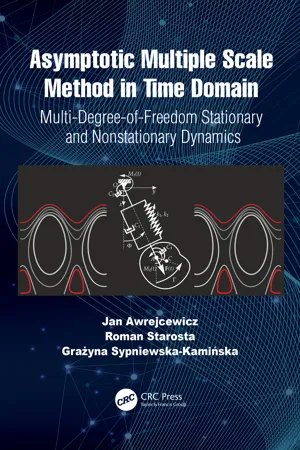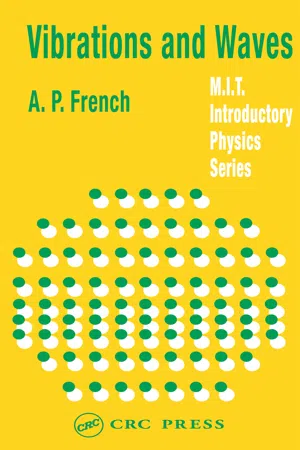Physics
Three Coupled Oscillators
Three coupled oscillators refer to a system of three oscillators that are connected to each other through springs. The motion of each oscillator is dependent on the motion of the other two, resulting in complex and interesting behavior. This system is commonly used in physics to study wave phenomena and resonance.
Written by Perlego with AI-assistance
Related key terms
Related key terms
1 of 4
Related key terms
1 of 3
3 Key excerpts on "Three Coupled Oscillators"
- eBook - ePub
Asymptotic Multiple Scale Method in Time Domain
Multi-Degree-of-Freedom Stationary and Nonstationary Dynamics
- Jan Awrejcewicz, Roman Starosta, Grażyna Sypniewska-Kamińska(Authors)
- 2022(Publication Date)
- CRC Press(Publisher)
105 ]).This chapter examines the motion of coupled oscillators with two degrees of freedom under periodic excitation. The dynamics of such a system is very complicated (Awrejcewicz [17]). The method used here consists of two major steps. The first is to simplify the problem by extracting internal motion in the system and describing it with an appropriate, one effective equation of motion. The effective equation for a similar system was investigated by Kyziol and Okniński [111 ], Okniński and Kyziol [159 ]. The second step is to analyze the dynamics of the effective equation. For this purpose, the main idea contained in the work (Okniński and Kyziol [160 ]) was adapted. In the latter work the authors used an innovative approach allowing for qualitative and quantitative study of the behavior of nonlinear systems with one degree of freedom, exchanging energy with external excitation.It is obvious that in general, reduction of 2 DoF systems to 1 DoF systems is impossible. Besides the mentioned work, we have found the earlier investigation of Hough (1988) where a 2 DoF conservative mechanical system was reduced to 1 DoF kinematic system under the change of an independent variable. With the help of Hamiltonian integral, the problem was simplified to study a second-order ODE for function specifying the orbital curve.7.2 Harmonic oscillator with added nonlinear oscillator
In many cases, the displacement of real mechanical system is relatively small during operations, so their dynamical behavior can be described using linear differential equations with good approximation. The elimination of undesirable vibrations can be achieved by attaching to such a device an oscillator with a low mass and appropriately selected nonlinear characteristics. Therefore, an important issue from the point of view of potential practical applications is the dynamic analysis of two coupled oscillators, one of which the higher mass is linear. - eBook - ePub
- H. John Pain(Author)
- 2013(Publication Date)
- Wiley(Publisher)
4
Coupled Oscillations
The preceding chapters have shown in some detail how a single vibrating system will behave. Oscillators, however, rarely exist in complete isolation; wave motion owes its existence to neighbouring vibrating systems which are able to transmit their energy to each other.Such energy transfer takes place, in general, because two oscillators share a common component, capacitance or stiffness, inductance or mass, or resistance. Resistance coupling inevitably brings energy loss and a rapid decay in the vibration, but coupling by either of the other two parameters consumes no power, and continuous energy transfer over many oscillators is possible. This is the basis of wave motion.We shall investigate first a mechanical example of stiffness coupling between two pendulums. Two atoms set in a crystal lattice experience a mutual coupling force and would be amenable to a similar treatment. Then we investigate an example of mass, or inductive, coupling, and finally we consider the coupled motion of an extended array of oscillators which leads us naturally into a discussion on wave motion.Stiffness (or Capacitance) Coupled Oscillators
Figure 4.1 shows two identical pendulums, each having a mass m suspended on a light rigid rod of length l . The masses are connected by a light spring of stiffness s whose natural length equals the distance between the masses when neither is displaced from equilibrium. The small oscillations we discuss are restricted to the plane of the paper.If x and y are the respective displacements of the masses, then the equations of motion areandFigure 4.1Two identical pendulums, each a light rigid rod of length l supporting a mass m and coupled by a weightless spring of stiffness s and of natural length equal to the separation of the masses at zero displacementThese represent the normal simple harmonic motion terms of each pendulum plus a coupling term s (x − y ) from the spring. We see that if x > y the spring is extended beyond its normal length and will act against the acceleration of x but in favour of the acceleration of y - eBook - ePub
- A.P. French(Author)
- 2017(Publication Date)
- CRC Press(Publisher)
1 This whole chapter may be bypassed if it is preferred to proceed directly to the discussion of vibrations and waves in effectively continuous media. On the other hand, an acquaintance with the contents of the present chapter, even in rather general terms, may help in appreciating the sequel, for the many-particle system does provide the natural link between the single oscillator and the continuum. And it is not as mathematically formidable as it may appear at first sight.Fig. 5-1 First three normal modes of vertical chain with upper end fixed. (The tension is provided at each point by the weight of the chain below that point and so increases linearly with distance from the bottom. )How do we go about the job of accounting for these numerous modes and calculating their frequencies? The clue to this question lies in the fact that an extended object can be regarded as a large number of simple oscillators coupled together. A solid body, for example, is composed of many atoms or molecules. Every atom may behave as an oscillator, vibrating about an equilibrium position. But the motion of each atom affects its neighbors so that, in effect, all the atoms of the solid are coupled together. The question then becomes: How does the coupling affect the behavior of the individual oscillators?We shall begin by discussing in some detail the properties of a system of just two coupled oscillators. The change from one oscillator to two may seem rather trivial, but this new system has some novel and surprising features. Moreover, in analyzing its behavior we shall develop essentially all the theoretical tools we need to handle the problem of an arbitrarily large number of coupled oscillators—which will be our ultimate concern. And this means that, from quite simple beginnings, we can end up with a significant insight into the dynamical properties of something as complicated as a crystal lattice. That is no small achievement, and it is worth the little extra amount of mathematical effort that our discussion will entail.Two Coupled Pendulums
Let us begin with a very simple example. Take two identical pendulums, A and B, and connect them with a spring whose relaxed length is exactly equal to the distance between the pendulum bobs, as shown in Fig. 5-2 . Draw pendulum A aside while holding Β
Index pages curate the most relevant extracts from our library of academic textbooks. They’ve been created using an in-house natural language model (NLM), each adding context and meaning to key research topics.
Explore more topic indexes
Explore more topic indexes
1 of 6
Explore more topic indexes
1 of 4


